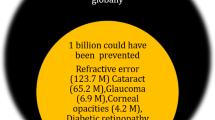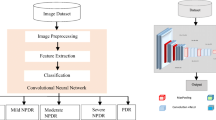Abstract
Diabetic macular edema (DME) is the expansion of the disease diabetic retinopathy (DR). Diabetic persons with a severe risk of DME can enter the phase of irreversible vision loss. To avoid this stage, patients must undergo identification and treatment twice a year. For identification purposes, this paper introduces a method called Squeeze-and-Excitation embedded DenseNet121 (SEDense) to classify the severity of DME grades. Pre-processing, such as augmentation and green channel extraction, is performed. The augmentation produces 1170 images from the original 413 images to train. The SEDense is assessed using 103 retinal fundus images. SEDense outperformed other state-of-the-art models presented in the “Diabetic Retinopathy - Segmentation and Grading Challenge” at ISBI-2018. It classifies the DME grades with 88.35% accuracy. The proposed SEDense model reduces the hassle of ophthalmologists in diagnosing DME grades.











Similar content being viewed by others
Data Availability
IDRiD dataset is available at https://ieee-dataport.org/open-access/indian-diabetic-retinopathy-image-dataset-idrid
References
Acharya UR, Mookiah MRK, Koh JE, Tan JH, Bhandary SV, Rao AK, Hagiwara Y, Chua CK, Laude A (2017) Automated diabetic macular edema (dme) grading system using dwt, dct features and maculopathy index. Computers in biology and medicine 84:59–68
Giancardo L, Meriaudeau F, Karnowski TP, Tobin KW, Grisan E, Favaro P, Ruggeri A, Chaum E (2010) Textureless macula swelling detection with multiple retinal fundus images. IEEE transactions on biomedical engineering 58(3):795–799
Hee MR, Puliafito CA, Wong C, Duker JS, Reichel E, Rutledge B, Schuman JS, Swanson EA, Fujimoto JG (1995) Quantitative assessment of macular edema with optical coherence tomography. Archives of ophthalmology 113(8):1019–1029
Breiman L (2001) Random forests. Machine learning 45:5–32
Chalakkal R, Hafiz F, Abdulla W, Swain A (2021) An efficient framework for automated screening of clinically significant macular edema. Computers in biology and medicine 130:104128
Porwal P, Pachade S, Kamble R, Kokare M, Deshmukh G, Sahasrabuddhe V, Meriaudeau F (2018) Indian diabetic retinopathy image dataset (idrid): a database for diabetic retinopathy screening research. Data 3(3):25
Chowriappa P, Dua S, Acharya UR, Krishnan MMR (2013) Ensemble selection for feature-based classification of diabetic maculopathy images. Computers in biology and medicine 43(12):2156–2162
Davidson JA, Ciulla TA, McGill JB, Kles KA, Anderson PW (2007) How the diabetic eye loses vision. Endocrine 32(1):107–116
dos Santos JCM, Carrijo GA, de Fátima dos Santos Cardoso C, Ferreira JC, Sousa PM, Patrocínio AC, (2020) Fundus image quality enhancement for blood vessel detection via a neural network using clahe and wiener filter. Research on biomedical engineering 36:107–119
Ferris FL (1993) How effective are treatments for diabetic retinopathy? Jama 269(10):1290–1291
Gayathri S, Gopi VP, Palanisamy P (2020) A lightweight cnn for diabetic retinopathy classification from fundus images. Biomedical signal processing and control 62:102115
Giancardo L, Meriaudeau F, Karnowski TP, Tobin KW, Grisan E, Favaro P, Ruggeri A, Chaum E (2010) Textureless macula swelling detection with multiple retinal fundus images. IEEE transactions on biomedical engineering 58(3):795–799
Giancardo L, Meriaudeau F, Karnowski TP, Li Y, Garg S, Tobin KW Jr, Chaum E (2012) Exudate-based diabetic macular edema detection in fundus images using publicly available datasets. Medical image analysis 16(1):216–226
Ren F, Cao P, Zhao D, Wan C (2018) Diabetic macular edema grading in retinal images using vector quantization and semi-supervised learning. Technology and health care 26(S1):389–397
Hee MR, Puliafito CA, Wong C, Duker JS, Reichel E, Rutledge B, Schuman JS, Swanson EA, Fujimoto JG (1995) Quantitative assessment of macular edema with optical coherence tomography. Archives of ophthalmology 113(8):1019–1029
Iandola F, Moskewicz M, Karayev S, Girshick R, Darrell T, Keutzer K (2014) Densenet: Implementing efficient convnet descriptor pyramids. arXiv preprint arXiv:1404.1869
Hu J, Shen L, Sun G (2018) Squeeze-and-excitation networks. In Proceedings of the IEEE conference on computer vision and pattern recognition, pp 7132–7141
Saman G, Gohar N, Noor S, Shahnaz A, Idress S, Jehan N, Rashid R, Khattak SS (2020) Automatic detection and severity classification of diabetic retinopathy. Multimedia Tools Appl 79:31803–31817
Rekhi RS, Issac A, Dutta MK (2017) Automated detection and grading of diabetic macular edema from digital colour fundus images. In 2017 4th IEEE uttar pradesh section international conference on electrical, computer and electronics (UPCON), pp 482–486 IEEE
Acharya UR, Mookiah MRK, Koh JE, Tan JH, Bhandary SV, Rao AK, Hagiwara Y, Chua CK, Laude A (2017) Automated diabetic macular edema (dme) grading system using dwt, dct features and maculopathy index. Computers in biology and medicine 84:59–68
Jadhav AS, Patil PB, Biradar S (2021) Optimal feature selection-based diabetic retinopathy detection using improved rider optimization algorithm enabled with deep learning. Evolutionary intelligence 14(4):1431–1448
Lim S, Ahmed M, Lim S (2017) Automatic classification of diabetic macular edema using a modified completed local binary pattern (clbp). In 2017 IEEE international conference on signal and image processing applications (ICSIPA), pp 6–10 IEEE
Jones S, Edwards R (2010) Diabetic retinopathy screening: a systematic review of the economic evidence. Diabetic medicine 27(3):249–256
Kollias AN, Ulbig MW (2010) Diabetic retinopathy: early diagnosis and effective treatment. Deutsches arzteblatt international 107(5):75
Krizhevsky A, Sutskever I, Hinton GE (2017) Imagenet classification with deep convolutional neural networks. Commun ACM 60(6):84–90
Kumar Y, Gupta S (2023) Deep transfer learning approaches to predict glaucoma, cataract, choroidal neovascularization, diabetic macular edema, drusen and healthy eyes: an experimental review. Arch Comput Methods Eng 30(1):521–541
Kumar A, Tewari AS (2022) Risk identification of diabetic macular edema using e-adoption of emerging technology. International journal of E-adoption (IJEA) 14(3):1–20
Giancardo L, Meriaudeau F, Karnowski TP, Li Y, Garg S, Tobin Jr KW, Chaum E (2012) Exudate-based diabetic macular edema detection in fundus images using publicly available datasets. Medical image analysis 16(1):216–226
Ramasubramanian B, Mahendran G (2012) An efficient integrated approach for the detection of exudates and diabetic maculopathy in colour fundus images. Advanced computing 3(5):83
Lee S, Fallah N, Forooghian F, Ko A, Pakzad-Vaezi K, Merkur AB, Kirker AW, Albiani DA, Young M, Sarunic MV et al (2013) Comparative analysis of repeatability of manual and automated choroidal thickness measurements in nonneovascular age-related macular degeneration. Investigative ophthalmology & visual science 54(4):2864–2871
Chalakkal R, Hafiz F, Abdulla W, Swain A (2021) An efficient framework for automated screening of clinically significant macular edema. Computers in biology and medicine 130:104128
Li K, Wu X, Chen DZ, Sonka M (2005) Optimal surface segmentation in volumetric images-a graph-theoretic approach. IEEE transactions on pattern analysis and machine intelligence 28(1):119–134
Baby CG, Chandy DA (2013) Content-based retinal image retrieval using dual-tree complex wavelet transform. In 2013 International conference on signal processing, image processing & pattern recognition, pp 195–199 IEEE
Lu D, Heisler M, Lee S, Ding GW, Navajas E, Sarunic MV, Beg MF (2019) Deep-learning based multiclass retinal fluid segmentation and detection in optical coherence tomography images using a fully convolutional neural network. Medical image analysis 54:100–110
Lin S, Ramulu P, Lamoureux EL, Sabanayagam C (2016) Addressing risk factors, screening, and preventative treatment for diabetic retinopathy in developing countries: a review. Clinical & experimental ophthalmology 44(4):300–320
Lee S, Fallah N, Forooghian F, Ko A, Pakzad-Vaezi K, Merkur AB, Kirker AW, Albiani DA, Young M, Sarunic MV, et al. (2013) Comparative analysis of repeatability of manual and automated choroidal thickness measurements in nonneovascular age-related macular degeneration. Investigative ophthalmology & visual science 54(4):2864–2871
Lu D, Heisler M, Lee S, Ding GW, Navajas E, Sarunic MV, Beg MF (2019) Deep-learning based multiclass retinal fluid segmentation and detection in optical coherence tomography images using a fully convolutional neural network. Medical image analysis 54:100–110
Kumar A, Tewari AS (2022) Risk identification of diabetic macular edema using e-adoption of emerging technology. International journal of E-adoption (IJEA) 14(3):1–20
Math L, Fatima R (2021) Adaptive machine learning classification for diabetic retinopathy. Multimedia Tools Appl 80(4):5173–5186
Murugan R, Roy P, Singh U (2020) An abnormality detection of retinal fundus images by deep convolutional neural networks. Multimedia Tools Appl 79:24949–24967
Singh RK, Gorantla R (2020) Dmenet: diabetic macular edema diagnosis using hierarchical ensemble of cnns. Plos one 15(2):0220677
Nair LR (2020) Retonet: a deep learning architecture for automated retinal ailment detection. Multimedia Tools Appl 79(21–22):15319–15328
Math L, Fatima R (2021) Adaptive machine learning classification for diabetic retinopathy. Multimedia Tools Appl 80(4):5173–5186
Porwal P, Pachade S, Kamble R, Kokare M, Deshmukh G, Sahasrabuddhe V, Meriaudeau F (2018) Indian diabetic retinopathy image dataset (idrid): a database for diabetic retinopathy screening research. Data 3(3):25
Porwal P, Pachade S, Kokare M, Deshmukh G, Son J, Bae W, Liu L, Wang J, Liu X, Gao L et al (2020) Idrid: Diabetic retinopathy-segmentation and grading challenge. Medical image analysis 59:101561
Randive SN, Rahulkar AD, Senapati RK (2018) Lvp extraction and triplet-based segmentation for diabetic retinopathy recognition. Evolutionary Intelligence 11:117–129
Jadhav AS, Patil PB, Biradar S (2021) Optimal feature selection-based diabetic retinopathy detection using improved rider optimization algorithm enabled with deep learning. Evolutionary intelligence 14(4):1431–1448
Rahim SS, Palade V, Shuttleworth J, Jayne C (2016) Automatic screening and classification of diabetic retinopathy and maculopathy using fuzzy image processing. Brain informatics 3:249–267
Raman R, Gella L, Srinivasan S, Sharma T (2016) Diabetic retinopathy: An epidemic at home and around the world. Indian journal of ophthalmology 64(1):69
Ramasubramanian B, Mahendran G (2012) An efficient integrated approach for the detection of exudates and diabetic maculopathy in colour fundus images. Advanced computing 3(5):83
Randive SN, Rahulkar AD, Senapati RK (2018) Lvp extraction and triplet-based segmentation for diabetic retinopathy recognition. Evolutionary Intelligence 11:117–129
He K, Zhang X, Ren S, Sun J (2016) Deep residual learning for image recognition. In Proceedings of the IEEE conference on computer vision and pattern recognition, pp 770–778
Ren F, Cao P, Zhao D, Wan C (2018) Diabetic macular edema grading in retinal images using vector quantization and semi-supervised learning. Technology and health care 26(S1):389–397
Lim S, Zaki W, Hussain A, Lim S, Kusalavan S (2011) Automatic classification of diabetic macular edema in digital fundus images. In 2011 IEEE colloquium on humanities, science and engineering. pp 265–269 IEEE
Saman G, Gohar N, Noor S, Shahnaz A, Idress S, Jehan N, Rashid R, Khattak SS (2020) Automatic detection and severity classification of diabetic retinopathy. Multimedia Tools Appl 79:31803–31817
Singh RK, Gorantla R (2020) Dmenet: diabetic macular edema diagnosis using hierarchical ensemble of cnns. Plos one 15(2):0220677
Syed AM, Akram MU, Akram T, Muzammal M, Khalid S, Khan MA (2018) Fundus images-based detection and grading of macular edema using robust macula localization. IEEE Access 6:58784–58793
Ting DSW, Cheung GCM, Wong TY (2016) Diabetic retinopathy: global prevalence, major risk factors, screening practices and public health challenges: a review. Clinical & experimental ophthalmology 44(4):260–277
Long J, Shelhamer E, Darrell T (2015) Fully convolutional networks for semantic segmentation. In Proceedings of the IEEE conference on computer vision and pattern recognition, pp 3431–3440
Wilkinson CP, Ferris FL III, Klein RE, Lee PP, Agardh CD, Davis M, Dills D, Kampik A, Pararajasegaram R, Verdaguer JT et al (2003) Proposed international clinical diabetic retinopathy and diabetic macular edema disease severity scales. Ophthalmology 110(9):1677–1682
Wu T, Liu L, Zhang T, Wu X (2022) Deep learning-based risk classification and auxiliary diagnosis of macular edema. Intelligence-Based Medicine 6:100053
Nair V, Hinton GE (2010) Rectified linear units improve restricted boltzmann machines. In Icml
Funding
No funding has been received
Author information
Authors and Affiliations
Corresponding author
Ethics declarations
Conflicts of interest/Competing interests
The authors declare that they do not have any conflict of interest
Additional information
Publisher's Note
Springer Nature remains neutral with regard to jurisdictional claims in published maps and institutional affiliations.
Rights and permissions
Springer Nature or its licensor (e.g. a society or other partner) holds exclusive rights to this article under a publishing agreement with the author(s) or other rightsholder(s); author self-archiving of the accepted manuscript version of this article is solely governed by the terms of such publishing agreement and applicable law.
About this article
Cite this article
Kumar, A., Tewari, A.S. Classifying diabetic macular edema grades using extended power of deep learning. Multimed Tools Appl 83, 14151–14172 (2024). https://doi.org/10.1007/s11042-023-15746-7
Received:
Revised:
Accepted:
Published:
Issue Date:
DOI: https://doi.org/10.1007/s11042-023-15746-7




